Dog Snapper
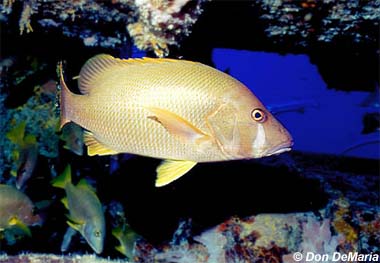
Lutjanus jocu
This snapper earned its name from the long canine teeth that show even when its mouth is closed. They are sturdy almond-shaped fish that are usually olive-green on top, fading to coppery pale underneath, and they have a distinct white triangular bar under their eyes. These nocturnally feeding reef fish average about 24 inches long but have been caught much larger. They’re a popular food fish but have been linked to cases of ciguatera poisoning because they are high on the reef food web and can build up the toxin in their flesh.
Order: Perciformes
Family: Lutjanidae
Genus: Lutjanus
Species: jocu
Common Names
English language common names include dog snapper, dogtooth snapper, dogteeth snapper, dog’s tooth snapper, dogteeth pargue, dogtooth parge, pargue, snuggletooth snapper, jocu, and snapper. Other names include barstebers (papiamento), bastaardbaars (dutch), bauna (portuguese), carde roulesse (french), dentao (portuguese), jocu parra (spanish), kibirefuedai (japanese), pargo (spanish), pargo jocu (spanish), pargo perro (spanish), pargo prieto (spanish), pargo rubio (spanish), pargue dent-chien (french), p’tit rouget (creole), sarde dent chien (french), and vivaneau chien (french).
Importance to Humans
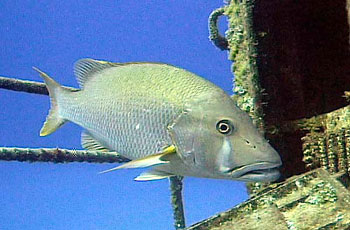
As a good quality foodfish, dog snappers are caught mainly with handlines, gill nets, traps, seines, and spears.
Danger to Humans
Although they are commercially fished, the dog snapper has been linked to ciguatera poisoning. Ciguatera is a toxin that originates with dinoflagellates. These microalgae are found on dead coral and benthic macroalgae. Herbivorous fish eat the coral and algae along with the dinoflagellates, and then are eaten by snappers. The toxins from the dinoflagellates build up in the snapper’s liver. When people eat snappers, if there is enough toxin, they will become ill. Usually ciguatera is associated with stomach discomfort and weakness of the arms and legs. Generally these feelings last for a day or two, and are not enough to cause serious pain in the persons affected.
Conservation
> Check the status of the dog snapper at the IUCN website.
The IUCN is a global union of states, governmental agencies, and non-governmental organizations in a partnership that assesses the conservation status of species.
Geographical Distribution
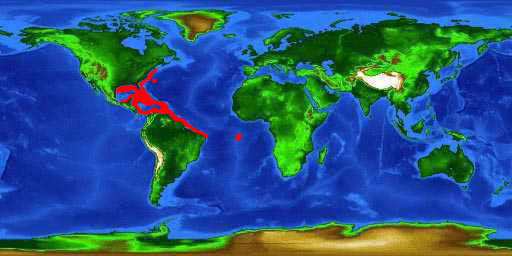
Lutjanus jocu is found in the western Atlantic Ocean, from Massachusetts to Brazil, although it is rare north of Florida. This fish is also found in the eastern Atlantic Ocean near St. Paul’s Rocks and Ascension Island.
Habitat
The adult dog snapper is commonly found around coral reefs and rocky bottoms at depths of 16-100 feet (5-30 meters), while the young can be seen in estuaries and have been known to go inshore and swim into rivers. The dog snapper is one of the only lutjanids to be found in freshwaters. Dog snappers are solitary and wary fish, preferring secluded areas of the reef.
Biology
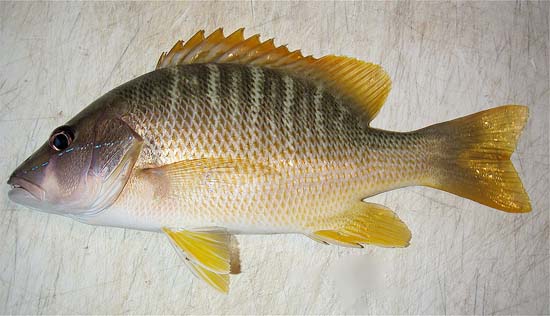
Distinctive Features
This snapper has a relatively deep body, with long pectoral fins, emarginate or weakly forked caudal fin, rounded anal fin, and a double dorsal fin.
Coloration
Dog snappers have olive green upper sides and backs, sometimes with narrow pale bars. The lower sides and belly are light red and copper-colored. Under the lower edge of the eyes is a white triangular bar. The pectoral, ventral, anal fins, and distal portions of the soft dorsal and caudal fins are reddish in color, while the rest of the dorsal and caudal fins are olive green. The young have a horizontal blue line below the eye and across the opercle, which turns into a row of spots on the adults.
Dentition
The dog snapper has pronounced canine teeth in the upper jaw, one pair of which can be seen when the jaw is closed. These canine teeth give the dog snapper a fierce look, hence its common name.
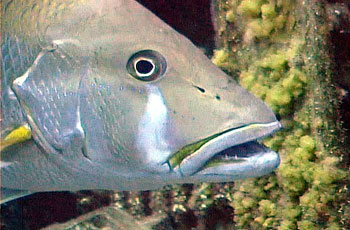
Size, Age, and Growth
With an average length of 24 inches (60 cm), the adult dog snapper may reach a maximum length of 30 inches (74 cm). The maximum weight known for this snapper is 20 lbs. (9.1 kg). Sexual maturity is obtained at lengths of 12-16 inches (30-40 cm).
Food Habits
Dog snappers prey nocturnally on smaller fish and benthic invertebrates, including shrimps, crabs, gastropods, and cephalopods.
Reproduction
The dog snapper typically spawns in March, near Jamaica and the northeastern Caribbean, although they do spawn to a lesser degree throughout their range. This snapper is similar to others in the Lutjanidae family in that its eggs and larvae are planktonic, dispersed by the ocean currents. There is little known about the larvae and its development. The post-larval stage eventually settles out of the plankton, onto suitable habitat that offers some protection from predators. These juveniles are red/brown laterally and dorsally with yellow ventral fins. There may be an oblique eye stripe. Eventually the juveniles move to coral reefs or rocky bottom habitats where they will live as adults.
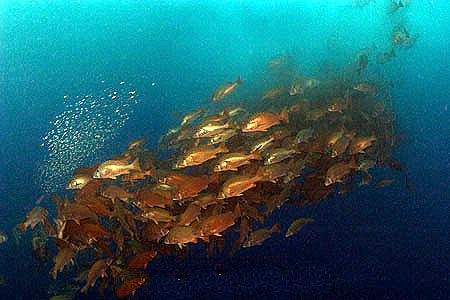
Predators
Large piscivorous fishes, including sharks and groupers, feed on the dog snapper. Larval and juvenile snappers provide food for a variety of marine organisms.Parasites
Platyhelminthes from the genus Euryhaliotrema have been found residing in the gills of various snapper species including the dog snapper.
Taxonomy
The dog snapper was first described by Bloch & Schneider (1801). It was originally referred to as Anthias jocu (Bloch and Schneider, 1801) but was later changed to Lutjanus jocu (Bloch and Schneider, 1801). Mesoprion litura Cuvier 1828 also refers to this snapper. Dog snappers are named for their large canine teeth that can be seen even when the jaw is closed.
Prepared by: Rebecca Murray